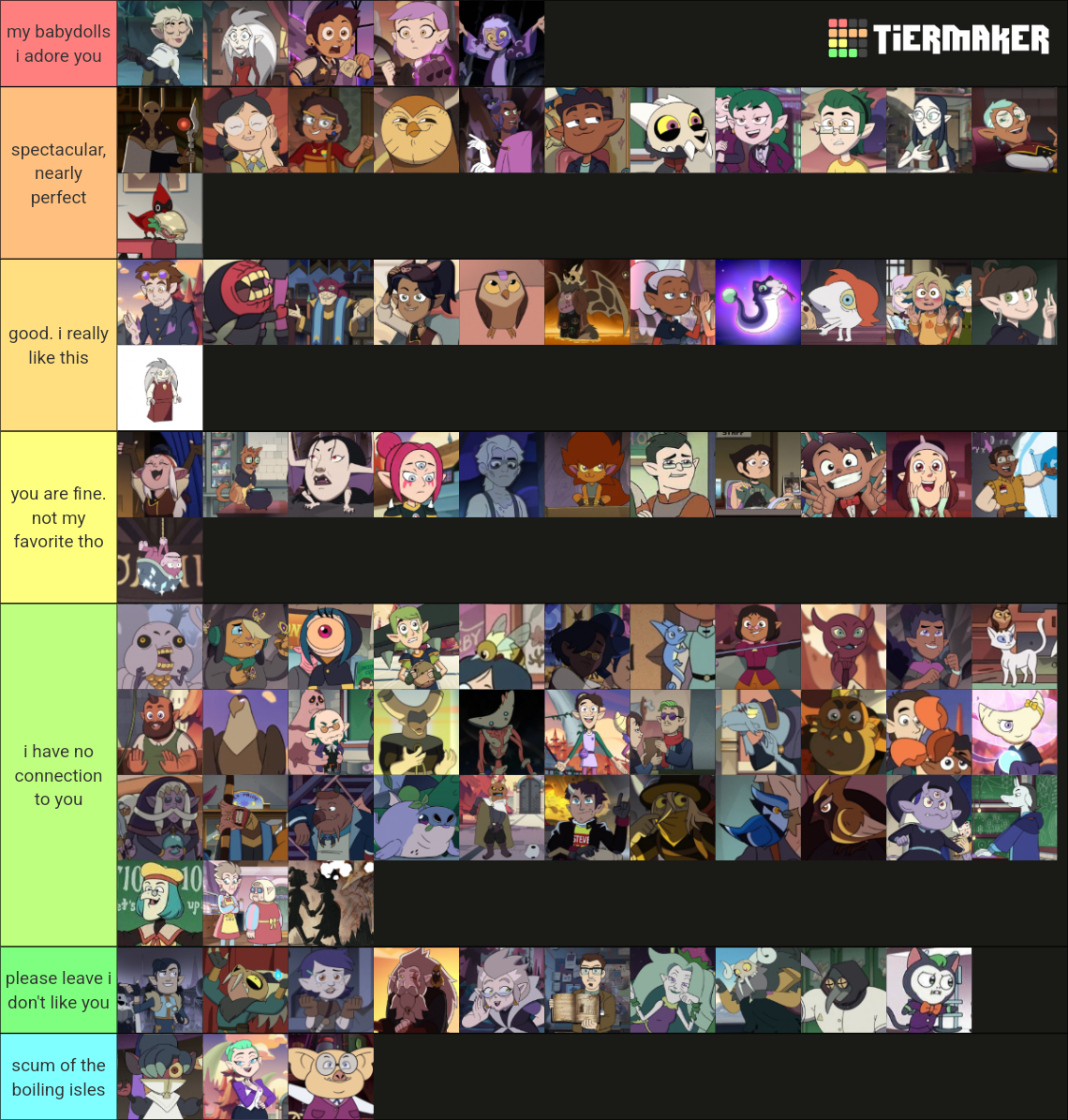The Owl House, a bewitching animated series that concluded its run in 2023, left an indelible mark on the landscape of modern fantasy storytelling. Its vibrant characters, each woven with intricate backstories and compelling motivations, resonated deeply with audiences. This examination delves into a hierarchical assessment of these luminaries, not merely ranking them based on arbitrary metrics, but rather exploring their multifaceted contributions to the narrative tapestry. Prepare for an atypical evaluation, one that challenges preconceived notions and encourages a reassessment of established favorites.
The Apex Tier: Architects of Narrative Zenith
This echelon is reserved for characters who fundamentally shaped the narrative arc, demonstrating profound growth and unwavering commitment to the central themes of acceptance and self-discovery. Luz Noceda, the spirited protagonist, unequivocally occupies this space. Her boundless optimism, coupled with her vulnerability and unwavering determination to find her place in a world that initially rejected her, anchors the entire series. Luz’s arc, from a bewildered human stumbling into a fantastical realm to a confident and compassionate witch-in-training, is a masterclass in character development. Her decisions, both noble and flawed, propel the narrative forward and force the audience to confront their own biases and assumptions.
Eda Clawthorne, the renegade mentor with a penchant for the unconventional, also merits placement in this upper stratum. Beneath her seemingly callous exterior lies a deeply empathetic soul burdened by past trauma and a self-imposed exile from her family. Eda’s transformation from a cynical outcast to a fiercely protective guardian of Luz and King is arguably one of the most rewarding character arcs in the show. Her willingness to confront her own demons and embrace vulnerability solidifies her status as a pivotal figure in the narrative. She embodies resilience, defying societal expectations and embracing her individuality with unapologetic fervor. This sets her apart.
King Clawthorne, the self-proclaimed “King of Demons,” undergoes a surprising and poignant metamorphosis throughout the series. Initially presented as a comedic foil, King’s backstory unravels to reveal a profound loneliness and a longing for belonging. His eventual acceptance of his true identity and his burgeoning relationships with Luz and Eda provide some of the most emotionally resonant moments of the show. He transitions from a caricature to a character of surprising depth, a testament to the show’s skillful writing.
The Ascendant Tier: Catalysts of Character Development
Characters in this grouping significantly influenced the development of other key figures, often serving as catalysts for change and growth. Amity Blight’s journey from a rigid, ambitious prodigy to a compassionate and fiercely loyal companion is a compelling illustration of this principle. Her evolving relationship with Luz challenges her ingrained prejudices and allows her to embrace her true self. Amity’s arc exemplifies the transformative power of genuine connection and the courage required to defy societal pressures.
Willow Park, often underestimated due to her initial lack of confidence, blossoms into a formidable witch with unwavering loyalty to her friends. Her resilience in the face of adversity and her unwavering commitment to justice make her an inspiring figure. Willow’s growth showcases the importance of self-belief and the strength that can be found in community.
Gus Porter, the prodigious illusionist, provides a crucial perspective on the importance of embracing one’s passions and celebrating cultural heritage. His enthusiasm for human customs, often perceived as eccentric by his peers, serves as a bridge between the human and demon realms. Gus’s optimism and unwavering support for his friends make him an invaluable member of the group.
The Groundwork Tier: Essential Supports to the Story
While not necessarily driving the central plot, these characters provided essential support to the main cast and contributed significantly to the world-building. Hooty, the sentient house, is a prime example. Despite his often-annoying antics, Hooty’s unwavering loyalty to the Owl House residents and his occasional moments of surprising insight make him a beloved, if peculiar, member of the ensemble. He embodies a chaotic, yet undeniably endearing, form of protectiveness.
Lilith Clawthorne, Eda’s older sister, initially presented as an antagonist, undergoes a complex journey of redemption. Her motivations, driven by a desire to protect her sister, are gradually revealed, adding depth and nuance to her character. Lilith’s eventual alliance with Luz and Eda demonstrates the possibility of reconciliation and forgiveness, even in the face of profound betrayal.
The Supporting Tier: Enriching the World
Characters in this tier, while not centrally featured, enrich the world of the Boiling Isles and contribute to its vibrant tapestry. Principal Bump, the seemingly strict but ultimately well-meaning headmaster of Hexside School, provides a crucial sense of order and structure within the chaotic realm of magic. His genuine concern for his students, even those who challenge his authority, makes him a respected figure.
Viney, Barcus, and the other students of Hexside provide a glimpse into the diverse perspectives and experiences within the witch community. Their individual quirks and talents contribute to the richness of the show’s world-building.
The Antagonistic Tier: Necessary Foils
These characters, while often morally reprehensible, serve as crucial foils to the protagonists, highlighting their strengths and reinforcing the central themes of the show. Emperor Belos, the tyrannical ruler of the Boiling Isles, embodies the dangers of unchecked power and the destructive consequences of prejudice. His manipulative tactics and unwavering commitment to his twisted ideology make him a formidable adversary.
Kikimora, Belos’s ambitious and ruthless lieutenant, represents the perils of blind obedience and the corrupting influence of power. Her unwavering loyalty to Belos, even in the face of his increasingly erratic behavior, highlights the dangers of sacrificing one’s own moral compass.
This examination, while comprehensive, is inherently subjective. Each viewer will undoubtedly form their own opinions on the relative merits of each character. The true power of “The Owl House” lies not in definitive rankings, but in its ability to spark meaningful conversations and encourage a deeper appreciation for the complexities of human (and demon) nature.
